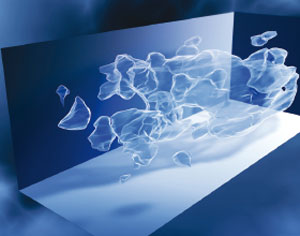Making a map of something that cannot be seen directly seems almost impossible, but it has been achieved by a wide international collaboration analysing a huge set of observations gathered by the Hubble Space Telescope (HST) and several ground observatories. The result is a 3D map of the distribution of dark matter in a large volume of the universe.

Evidence for dark matter goes back to 1933 when the Swiss astrophysicist Fritz Zwicky working at the California Institute of Technology (Caltech) deduced that the Coma cluster of galaxies would not remain bound together by gravity without the pull of an additional hidden mass. Over the course of decades, it became clear that dark matter is much more abundant in the universe than visible matter. Recent cosmology results further suggest that most of the dark matter is not made of ordinary matter composed of protons and neutrons, but is of a yet to be discovered non-baryonic nature (see CERN Courier May 2006 p12).
Direct evidence for dark matter being decoupled from ordinary matter was obtained last year (see CERN Courier October 2006 p9), an observation difficult to reconcile with alternative theories like Modified Newtonian Dynamics (MOND).
Until now, the ability to derive the spatial distribution of dark matter was limited to individual galaxies and clusters. The new study published in Nature goes a step further by tracing dark matter on a much wider scale on the sky and also in depth along the line of sight. The international collaboration led by Richard Massey, also from Caltech, analysed the Cosmic Evolution Survey (COSMOS), a mosaic of 575 pointings of the Advanced Camera for Surveys (ACS) aboard the HST covering almost 2 sq. deg. on the sky, about eight times the area of the Moon. Dark matter manifests itself by the gravitational deflection of light emitted by background sources. This gravitational-lensing effect slightly deforms the shape of remote galaxies. It is this subtle effect that was measured for about 500,000 galaxies in this survey and analysed statistically to derive the projected distribution of dark matter.
The mapping of the dark matter in the third dimension is achieved by carefully selecting galaxies according to distance. Their observed distortion is mainly affected by dark matter at about half this distance. Using this property, a first 3D map of dark matter could be constructed extending from a redshift of 0 to 1. The survey volume is therefore an elongated cone rather than a box extending over about 7 billion light-years. The determination of the distance to the galaxies obtained by measuring their photometric redshift required follow-up observations in 15 wavelength bands by four ground-based telescopes.
The map is quite rudimentary, with little evidence for the expected filamentary or “sponge-like” structure obtained by simulations of the building-up of large-scale structures in the universe. Nevertheless, it shows some evolution from a more homogeneous to a more clumpy distribution of dark matter as expected through self-gravity, and it paves the way to future surveys that should enable this kind of study to have higher resolution and cover much greater volumes of the universe.
Further reading
R Massey et al. 2007 Nature doi:10.1038/nature05497.








